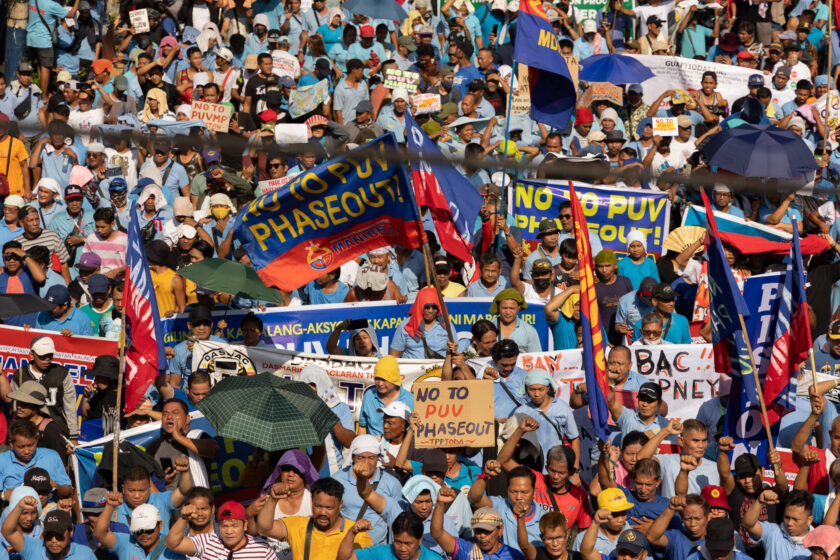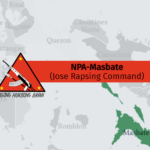
by DOMINIC GUTOMAN
Bulatlat.com
MANILA – Thousands of jeepney drivers and operators nationwide held a coordinated protest action on April 15 and 16.
This was part of the announced nationwide transport strike of the Pagkakaisa ng mga Samahan ng Tsuper at Operator Nationwide (PISTON) and Samahang Manibela Mananakay at Nagkaisang Terminal ng Transportasyon (MANIBELA) in response to the consolidation deadline on April 30.
President Ferdinand Marcos Jr. said that the consolidation will not be extended anymore.
For single-unit operators like Chel Mallonga, 45, the impact of the government’s Public Utility Vehicle Modernization Program (PUVMP) would be drastic. Once consolidation pushes through, single-unit operators will no longer be granted franchises.
“Basta na lang nila kami binigyan ng deadline na wala man lang pahintulot sa mahihirap na [tsuper at operator] tulad namin. Paano na yung mga pamilya namin kung itutuloy nila ang deadline na ‘yan,” Mallonga said in an interview with Bulatlat.
(They just gave us a deadline without the approval of the poor drivers and operators like us. How can we provide for our families if the deadline will push through?)
After the deadline, IBON Foundation said that only 68 percent of the jeepneys will be able to operate on the roads nationwide. On the other hand, the government stressed that at least 80 percent of PUV operators will be consolidated prior to the deadline.
Livelihood impact
Mallonga has been plying the Alabang-GMA route for almost two decades. He became a single-unit operator in 2019 when the amortization of his jeepney became fully paid. “Limang taon ko ring binayaran yung jeep na yun. Hinulugan ko ng P12,000 (US$209.82) kada buwan. Hirap na hirap pa ako noon.”
(For five years, I paid for my jeep. My amortization was P12,000 each month and it was too hard for me back then.)
He decided to be a single-unit operator to acquire the full earnings of his hard work every day. He earned from P2,500 to P3,000 (US$43.71-US$52.45) every day, saying that it is just enough for his family. “Mayroon akong limang anak, asawa, at mga binabayarang upa, kuryente, at tubig. Sa ngayon, nakasasapat ito. Pero kapag nagpatuloy ang consolidation deadline, maaari kaming maging sahuran na mga driver.”
(I have five children, a wife, and bills to pay – rent, electricity, water. For now, my earnings suffice. But if the consolidation deadline pushes through, we might become salaried drivers.)
If a jeepney driver does not own a unit, they are expected to pay the daily “boundary” to the operators for renting the vehicle.
Samuel Dizon, 59, has been working as a traditional jeepney driver for almost three decades. He started in Laguna and now plies the MCU-Rotonda route.
“Ang kinikita na lang namin ngayon ay nasa P500-P700 (US$8.74-US$12.24) sa loob ng tatlong ikot namin. Maliit yung take-home namin dahil napupunta lang ito sa krudo at boundary,” Dizon said, adding that his boundary or jeepney unit rental amounts to P1,150 (US$20.11) daily.
(Our income right now amounts to P500-P700 after three trips. We have a small take-home pay because of fuel expenses and boundary payment.)
Dizon’s situation shows that the boundary that goes to the operator is usually greater than the jeepney driver’s net income.
He said that small operators are severely affected by the consolidation deadline as many jeepney drivers under them can lose their livelihood. “Sa operator (owner of the jeepney unit) pa lang namin, bente-singko (25) driver na ang maaaring mawalan ng trabaho.”
(With our operator alone, 25 drivers are expected to lose their jobs.)
The tedious ride
There are several requirements for franchise consolidation. First, the drivers and operators must be members of a cooperative or a corporation, some of which require payment. Second, they should submit documentary requirements like the latest Land Transportation Office (LTO) official receipt, Certificate of Registration, Securities and Exchange Commission (SEC) Certificate or Office of Transportation Cooperatives (OTC) Certification, and affidavit of conformity.
However, these requirements may be challenging for small transport workers. “Sa pagpapa-member pa lang ng kooperatiba, kinakailangan na naming magbayad ng P40,000 hanggang P50,000 (US$699.40-US$874.25). Saan kami kukuha ng ganoon kung halos araw-araw ay hirap na kaming pagkasyahin yung kinikita namin?” Mallonga said.
(To be a member of a cooperative, we have to pay P40,000 to P50,000. Where can we get that amount of money if almost every day our earnings are not enough for our needs?)
He said that once they are consolidated, they have to submit the affidavit of conformity which will serve as “proof” that they are surrendering their units and existing franchise. “Pagkatapos noon, yung mga unit namin, ija-junk shop na lang dahil hindi na pwede ilabas sa kalsada. Wala nang rehistro.”
(After that, our units will be brought to the junk shops because they can no longer be used to ply the streets. The registration will be invalid.)
In a primer, a cooperative or a corporation has to buy a minimum of ten (10) to fifteen (15) modernized jeepneys. Each unit costs P2.4 million to P2.8 million (US$4.2 million to US$4.89 million) from the government’s private partners.
“Yung ibang kasamahan naming operators na nag-consolidate ay napakalaki nang binabayaran sa loob. Sa mga tsuper naman, malaki ang boundary. Sa ruta namin sa MCU-Divisoria, ang binabayaran ng operator kada buwan sa isang unit ay P55,000 (US$961.67),” Dizon said.
(Some of our fellow operators who have consolidated are paying a big amount of money. Meanwhile, the drivers have to meet the larger boundary. In the MCU-Divisoria route, the operator has to pay P55,000 for each unit monthly,)
This means that the high prices of the units and expenses of the cooperatives require greater boundary for the passenger trips. Transport workers need to meet a daily income of P6,899 to P7,000, which could also result in higher fares for commuters and longer working hours for the drivers.
IBON Foundation listed several out-of-pocket expenses that the cooperatives need to shoulder aside from the modernized jeepney units. Among these are costs for maintenance, parts and repairs, fuel, franchise consolidation fees, parking space, administrative expenses, and wages of the transport workers.
Alternative routes
Both transport workers said that the phaseout of traditional jeepneys is not a feasible option. However, Mallonga said that he is willing to make compromises and put together necessary changes with his jeepney to reach “road-worthy” standards. “Susunod naman kaming mga traditional jeepney sa standards kung kailangan ayusin. Ang amin lang, tuparin nila yung sinabi nila noong eleksyon na walang maiiwan.”
(We traditional jeepney [drivers] are willing to follow the standards if there are modifications that need to be done. For us, they have to follow their election promise that we will not be left behind,)
In fact, one of the recommendations of a research from UP Center for Integrative and Development Studies (CIDS) is for the government to subsidize the traditional jeepneys’ rehabilitation which can also be a good alternative to reduce carbon emissions.
Dizon said that if modernization will push through, local manufacturers must be the main producers of the materials so that jeepney drivers and operators can afford to buy them. “Ang gawa ng mga lokal na manufacturer para sa amin ay mas mura, matibay, at syempre, sariling gawa ng mga Pilipino.”
(For us, those made by local manufacturers are cheaper, sturdy, and of course, made by our fellow Filipinos.)
Among the manufacturers he mentioned is Francisco Motors Corporation. They offered a modernized jeepney for as low as P985,000 (US$17,222.69), which is relatively lower than the government’s partners Hino Toyota, Hyundai, and Fuso Mitsubishi. “Naniniwala kami na itong isinusulong ng pamahalaan ay negosyo-modernisasyon. Hindi ito modernisasyon para sa mga sasakyan. Ang layunin natin kung tayo ay magsusulong ng modernisasyon, dapat progresibo, maka-masang transportasyon, at hindi maka-dayuhan.”
(We believe that this modernization of the government prioritizes business and profit. This is not a modernization for our vehicles. Our objective is to push for modernization that is progressive, pro-masses, not for foreign entities,)
In a January 24 congressional hearing on the PUVMP, Kabataan Partylist Rep. Raoul Manuel condemned the misleading numbers on the ownership and manufacturing of modern jeepneys.
“Bagama’t may almost 5,000 PUV units classified as locally manufactured or assembled, marami sa kanilang mother companies ay mula sa ibang bansa. Kung tutuusin, 93 percent ng lahat ng modern PUV units ay mula sa foreign companies,” Manuel said, adding that local manufacturers should be prioritized in the PUVMP.
(Although there are almost 5,000 PUV units classified as locally manufactured or assembled, many of their mother companies are from other countries. In fact, 93 percent of the modern PUV units came from these foreign companies,)
The strike continues
The Metropolitan Manila Development Authority (MMDA) and DOTr, tried to downplay the nationwide strike organized by PISTON and MANIBELA. DOTr Secretary Jaime Bautista said that strikes did not paralyze the transport system.
However, PISTON said on April 15 alone, 80 percent of the major routes in Metro Manila, including some parts of Cavite and Laguna, were paralyzed. They added that 90 percent of traffic in Bacolod City was paralyzed due to the strike.
“The government’s attempts to downplay the strike’s impact are futile. Stranded commuters line Commonwealth Ave and other major routes, while schools and universities have suspended classes or shifted to online, and the massive police presence that aims to quell mobilizations only goes to show the impact of the strike,” PISTON said in a statement.
Drivers, operators, commuters, and advocates who joined the protest caravan on April 15 were blocked by the Philippine National Police (PNP) several times. As a result, they occupied the southbound lane of Quezon Avenue from Welcome Rotonda to Blumentritt Street to camp overnight.
“Sinacrifice talaga namin yung araw [para mag-strike] para makita ng taumbayan kung gaano karami ang magugutom sa susunod na buwan,” Mallonga said.
(We sacrificed this day for the strike, to let the people know that many of us will be left to starve in the next month,)
He added, “Pinaglalaban namin ang aming hanapbuhay nang tama kaya wag nila sanang basta alisin. Parang kriminal ang turing sa amin pero kami naman ay nagbabayad nang tama, nagpaparehistro, ligal ang mga dokumento namin, pero pinipilit kaming alisin sa kalsada.”
(We are fighting for our livelihood the right way, so we hope that they do not easily take this away from us. We are being treated like a criminal but we are following the proper procedures from payment, registration, and the submission of documents. We are being pushed away from the roads.)
PISTON and MANIBELA plan to continue a series of protest actions and strike until April 30, demanding that the Marcos administration heed their staunch opposition against the traditional PUV phaseout. (RTS, DAA, RVO)



